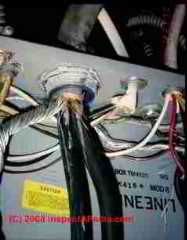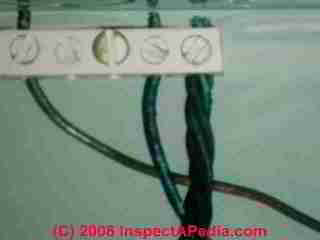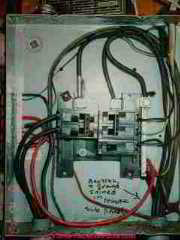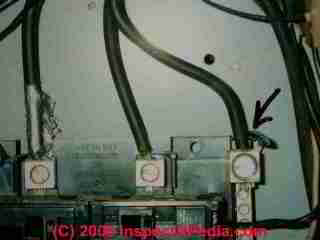 Electrical Panel Interior Hazards for Electrical & Home Inspectors
Electrical Panel Interior Hazards for Electrical & Home Inspectors
- POST a QUESTION or COMMENT about visible dangers & defects inside of the electrical panel
How to inspect the interior of an electrical panel: this article discusses inspection procedures & safety hazards inside residential electrical panels - special concerns to inspectors and electricians.
We suggests safety procedures for the electrical inspector, home inspector, or other professionals who examine residential electrical systems.
InspectAPedia tolerates no conflicts of interest. We have no relationship with advertisers, products, or services discussed at this website.
- Daniel Friedman, Publisher/Editor/Author - See WHO ARE WE?
What to Look for Inside the Electrical Panel as Immediate Safety Concerns to the Inspector
These electrical inspection suggestions are not a complete inventory of all electrical safety procedures nor of all electrical components that should be inspected; these notes focus on identification of conditions that may present special electrical hazards for the electrical inspector. Contact Us by email to suggest changes, corrections, and additions to this material.
Fatal Shock Hazard Warning: Inspecting electrical components and systems risks death by electrocution as well as serious burns or other injuries to the inspector or to others. Do not attempt these tasks unless you are properly trained and equipped.
- Evidence of water entry inside the electrical panel (photo at below right) means that circuit breakers may be corroded and won't trip, connections may be unreliable, neutral or ground connections may be lost, and touching the equipment could be dangerous.
- Evidence of overheating, melting, burnups inside the electrical panel (photo at below right) - this was the ground that overheated when there was no neutral connection in the sub panel and neutral and ground buses were improperly bonded.


[Click to enlarge any image]
- Evidence of missing bonding or improper bonding (such as ground to neutral in a sub panel) may combine with evidence of overheating (photo above left) to indicate improper wiring, damaged equipment, and unsafe conditions.
The loss of netural connection in a garage sub panel (the steel screw bound in the aluminum neutral lug in photo at below right) combined with improper bonding (ground to neutral - red wire in photo at below left) and other conditions to shock an owner when he touched his metal workbench.
See Case History:Loss of Neutral Shocks Homeowner for details of this case.


- Evidence of burned or overheated wires or damaged circuit breakers, aluminum wiring, faulty equipment, mis-wiring, linking, bus and bonding defects, and many other defects form part of the electrical panel inspection and are described outside of this safety procedures article -
see ELECTRIC PANEL INSPECTION
In addition to examining the electrical panel before touching it, looking for dangerous conditions like water, rust, sheet metal screws, rats, and blocking client access, the inspector should also recognize that certain brands or models of electrical equipment are known to be unsafe and may be dangerous to inspect or operate.
Federal Pacific Electric Stab-Lok equipment includes breakers which remain internally "on" when switched "off", as well as too often failing to trip off in response to an overcurrent, and which have been reported to result in electrical arc explosions when manually or otherwise exercised.
Zinsco: Similar bus burnups and electrical arc explosions have been reported regarding Sylvania/Zinsco electrical panels.
Contact Us by email to add field reports of problems regarding these or other electrical products.

Opening the electrical panel to examine overcurrent devices - fuses or circuit breakers, is discussed
Inspecting overcurrent devices - visual:
and ELECTRIC PANEL INSPECTION for detailed procedures. There is a huge amount of information about the electrical system inside of the electrical panels.
Reporting unsafe electrical panels:
see FEDERAL PACIFIC FPE HAZARDS
and see ZINSCO SYLVANIA ELECTRICAL PANELS
Do not try to "exercise" the breakers in these panels. Turning the circuit breaker on and off in an FPE Stab-Lok panel can actually increase the risk of a future failure to trip. We also have field reports of electrical arc explosions when these breakers have been switched on or off. Some examples are included in this series of electrical safety articles.
The inspector is not required to insert anything, finger, screwdriver, probe, into the electrical panel. The required inspection is visual. Observe. However an inspector is of course permitted to perform other tests or services which s/he chooses to provide (presuming s/he is qualified, trained, and that three are no conflicts of interest).
...
Continue reading at ELECTRICAL PANEL INSPECTION SAFETY or select a topic from the closely-related articles below, or see the complete ARTICLE INDEX.
Or see
ELECTRICAL INSPECTOR SAFETY PROCEDURES important basic safety procedures, clothing, and equipment for home inspectors and electrical inspectors.
LIGHTNING DAMAGE to ELECTRICAL SYSTEM
Suggested citation for this web page
ELECTRICAL PANEL INTERIOR HAZARDS at InspectApedia.com - online encyclopedia of building & environmental inspection, testing, diagnosis, repair, & problem prevention advice.
Or see this
INDEX to RELATED ARTICLES: ARTICLE INDEX to ELECTRICAL INSPECTION & TESTING
Or use the SEARCH BOX found below to Ask a Question or Search InspectApedia
Ask a Question or Search InspectApedia
Questions & answers or comments about shock and electrocution hazards when touching electrical equipment during an inspection.
Try the search box just below, or if you prefer, post a question or comment in the Comments box below and we will respond promptly.
Search the InspectApedia website
Note: appearance of your Comment below may be delayed: if your comment contains an image, photograph, web link, or text that looks to the software as if it might be a web link, your posting will appear after it has been approved by a moderator. Apologies for the delay.
Only one image can be added per comment but you can post as many comments, and therefore images, as you like.
You will not receive a notification when a response to your question has been posted.
Please bookmark this page to make it easy for you to check back for our response.
IF above you see "Comment Form is loading comments..." then COMMENT BOX - countable.ca / bawkbox.com IS NOT WORKING.
In any case you are welcome to send an email directly to us at InspectApedia.com at editor@inspectApedia.com
We'll reply to you directly. Please help us help you by noting, in your email, the URL of the InspectApedia page where you wanted to comment.
Citations & References
In addition to any citations in the article above, a full list is available on request.
- Electrical shock injury statistics: www.healthatoz.com - September 2008;
High-tension current generally causes the most serious injuries, although fatal electrocutions may occur with household current (e.g., 110 V in the United States and Canada and 220 V in Europe, Australia, and Asia). Contact with alternating current at 60 cycles per second (the frequency used in most US household and commercial sources of electricity) may cause tetanic skeletal muscle contractions, preventing self-release from the source of the electricity and thereby leading to prolonged exposure. The repetitive frequency of alternating current also increases the likelihood of current flow through the heart during the relative refractory period (the "vulnerable period") of the cardiac cycle. This exposure can precipitate ventricular fibrillation (VF), which is analogous to the R-on-T phenomenon.-- circ.ahajournals.org - September 2008
- Mark Cramer Inspection Services Mark Cramer, Tampa Florida, Mr. Cramer is a past president of ASHI, the American Society of Home Inspectors and is a Florida home inspector and home inspection educator. Mr. Cramer serves on the ASHI Home Inspection Standards. Contact Mark Cramer at: 727-595-4211 mark@BestTampaInspector.com
- John Cranor [Website: /www.house-whisperer.com ] is an ASHI member and a home inspector (The House Whisperer) is located in Glen Allen, VA 23060. He is also a contributor to InspectApedia.com in several technical areas such as plumbing and appliances (dryer vents). Contact Mr. Cranor at 804-873-8534 or by Email: johncranor@verizon.net
- "Frequency of Occurrence and Sources of Rust and Corrosion in Electrical Panels," Daniel Friedman, IEEE HOLM Conference, Philadelphia PA, 1992 - see ELECTRIC PANEL RUST for an online version of this article.
- Jim Simmons: Personal communication, J. Simmons to Daniel Friedman, 9/19/2008. Photographs contributed to this website by Jim P. Simmons, Licensed Electrician, 360-705-4225 Mr. Electric, Licensed Master Electrician, Olympia, Washington Contact Jim P. Simmons, Licensed Master Electrician, Mr. Electric, 1320 Dayton Street SE
Olympia, WA 98501, Ph 360-705-4225, Fx 360-705-0130 mrelectricwa@gmail.com - Kenneth Kruger: Original author of the sidebar on testing VOM DMM condition: Kenneth Kruger, R.A., P.E. AIA ASCE, is an ASHI Member and ASHI Director in Cambridge, MA. He provided basis for this article penned by DJ Friedman.
- "How to Use DMM's Safely," Leonard Ogden, CEE News, 888 Seventh Ave., New York, NY 10106, Dec 1990 p.10.
- Dr. Jess Aronstein, consulting engineer, Poughkeepsie NY, 1991 protune@aol.com
- Rex Cauldwell, master electrician and contributor to the Journal of Light ConstructionOn electrical topics
- New York State Central Hudson Gas and Electric Company, G&E/1-2/85 consumer safety pamphlet
- American Society of Home Inspectors, ASHI Training Manual, Al Alk -[obsolete, and includes unsafe practices-DF]
- "Electrical System Inspection Basics," Richard C. Wolcott, ASHI 8th Annual Education Conference, Boston 1985.
- "Simplified Electrical Wiring," Sears, Roebuck and Co., 15705 (F5428) Rev. 4-77 1977 [Lots of sketches of older-type service panels.]
- "How to plan and install electric wiring for homes, farms, garages, shops," Montgomery Ward Co., 83-850.
- "Home Wiring Inspection," Roswell W. Ard, Rodale's New Shelter, July/August, 1985 p. 35-40.
- "Evaluating Wiring in Older Minnesota Homes," Agricultural Extension Service, University of Minnesota, St. Paul, Minnesota 55108.
- "Electrical Systems," A Training Manual for Home Inspectors, Alfred L. Alk, American Society of Home Inspectors (ASHI), 1987, available from ASHI. [DF NOTE: I do NOT recommend this obsolete publication, though it was cited in the original Journal article as it contains unsafe inaccuracies]
- "Basic Housing Inspection," US DHEW, S352.75 U48, p.144, out of print, but is available in most state libraries.
- In addition to citations & references found in this article, see the research citations given at the end of the related articles found at our suggested
CONTINUE READING or RECOMMENDED ARTICLES.
- Carson, Dunlop & Associates Ltd., 120 Carlton Street Suite 407, Toronto ON M5A 4K2. Tel: (416) 964-9415 1-800-268-7070 Email: info@carsondunlop.com. Alan Carson is a past president of ASHI, the American Society of Home Inspectors.
Thanks to Alan Carson and Bob Dunlop, for permission for InspectAPedia to use text excerpts from The HOME REFERENCE BOOK - the Encyclopedia of Homes and to use illustrations from The ILLUSTRATED HOME .
Carson Dunlop Associates provides extensive home inspection education and report writing material. In gratitude we provide links to tsome Carson Dunlop Associates products and services.

